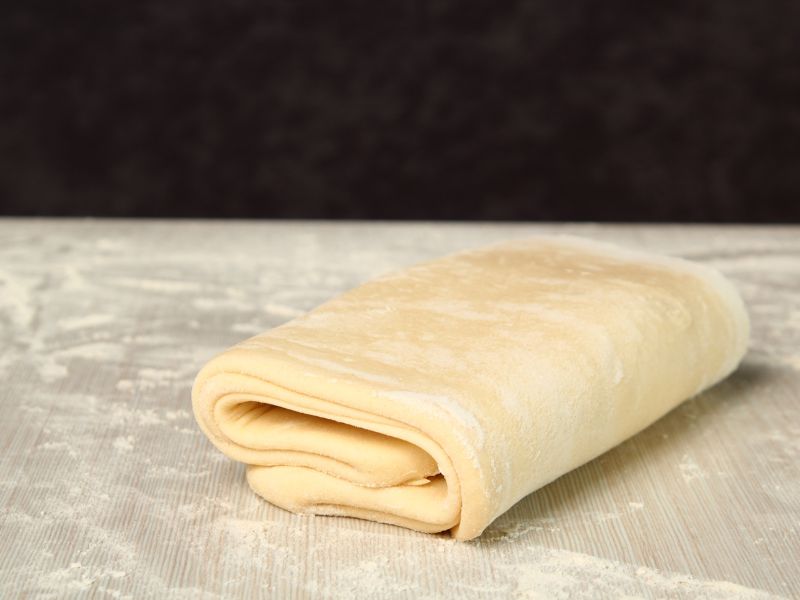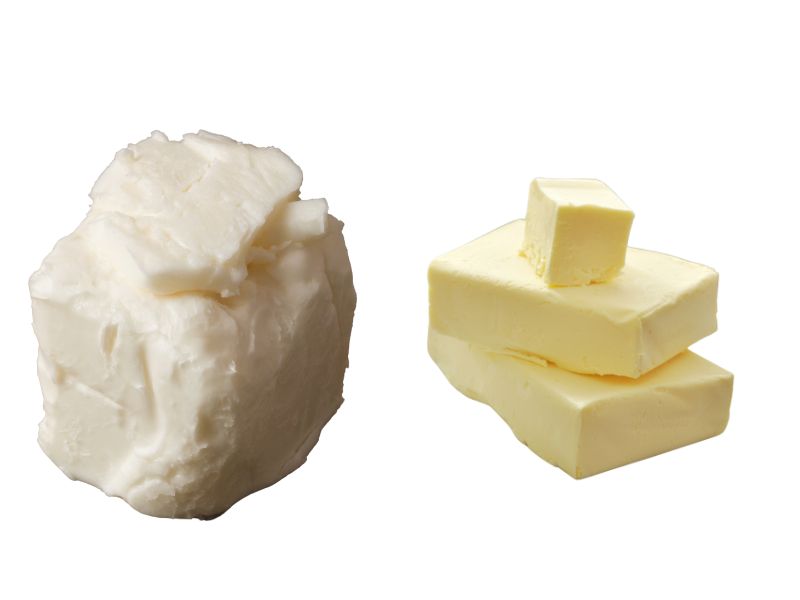Out of butter? But there is a can of shortening in your pantry. Hmm, Can you substitute shortening for butter? While butter and shortening are different products, with some simple adjustments, you can absolutely substitute shortening for butter in most baking recipes. But it isn’t a straightforward swap. It’s about understanding how this change affects flavor, texture, and overall baking chemistry.
Whether you’re an experienced baker or just starting out, come along with me as we explore the art of substitution, guaranteeing that your baked goods turn out delicious every time.
What’s the Difference Between Butter and Shortening Anyway?
Before we roll up our sleeves and get into the nitty-gritty of baking with shortening instead of butter, let’s quickly explore what sets butter apart from shortening.
Butter
Butter is the flavor king. A dairy product made from churning cream. Rich in flavor, it’s a baking staple known for its creamy texture and golden color. Butter is like the secret ingredient that gives classic baked goods their delicious, rich flavor. Whether it’s cookies or cakes, it adds a special depth and a subtle nutty hint. Butter’s special knack for creating soft, moist textures is why it’s so loved. It helps in rising and brings that delightful, melt-in-your-mouth quality to pastries.
Shortening
Shortening is the texture magician. A solid fat made from vegetable oils through a process called hydrogenation. It’s white, flavorless, and has a high melting point. Shortening is the secret to achieving flaky pie crusts and tender biscuits. Its 100% fat content provides a structure that’s hard to match. In warmer climates or seasons, shortening can be a lifesaver. It doesn’t melt as easily as butter, keeping your baked creations intact and beautiful.
Butter offers flavor and moisture, while flavorless shortening brings texture and a higher fat ratio.
Key Differences
Butter wins in the flavor department, hands down. Shortening, while neutral, lacks the rich, buttery taste.
Each behaves differently. Butter melts and spreads, creating a different texture in cookies and cakes compared to shortening.
What’s the Substitution Ratio for Butter vs. Shortening?
When using shortening in place of butter, the standard substitution ratio is:
1:1 (one-to-one) – For every cup of butter, use one cup of shortening.
Cookies A 1:1 ratio usually works well, keeping cookies tender without excessive spreading.
However, sometimes, a ratio of slightly less shortening is ideal since shortening has a higher fat percentage. For best results, try:
Slightly less shortening – Reduce to 3/4 cup + 2 tablespoons shortening per every cup of butter. For cakes, using a bit less shortening than butter can help maintain the desired moisture balance.
,
How Does Shortening Affect Texture, Appearance, and Flavor?
🍪 Effects on Baked Goods 🍰 |
||
|---|---|---|
| Aspect | Effect of Butter | Effect of Shortening |
| Texture | Rich and creamy | Flakier, crisper |
| Appearance | Golden brown color | Lighter, faster browning |
| Flavor | Rich, buttery | Neutral, less rich |
| Moisture Content | Moist | Drier texture |
| Brought to You by wearebaking.com | ||
Swapping out butter for shortening will definitely change the final look and taste. Here’s what to expect:
Impact on Texture
- Flakier, crisper texture – Shortening creates many thin flaky layers. Great for pie crusts!
- Less moisture & density – Lacks the water content in butter, so can seem drier.
- More tender crumb – With less gluten development. Start with less flour for cake-like softness.
Changes to Appearance
- Browns faster – Shortening has a lower smoke point than butter. Reduce oven temp by 25°F.
- Cooks quicker – Sets faster so keep a close eye on doneness.
- Lighter golden color – Has less milk solids to brown during baking.
Flavor Impacts
- Lacks rich taste – No creamy dairy goodness. Sigh!
- Neutral blank slate – Take the opportunity to add creative flavors!
- Can add butter extract – For a flavor boost to make up for the lack of butter’s characteristic taste.
Tips for Substitution Success
Balancing moisture levels and monitoring doneness is key when using shortening instead of butter. Here are some tips:
Adjust Baking Time or Temp
Since shortening sets up quicker, it can overbake if you’re not careful. Reduce oven temperature by 25°F and check goods early.
Let Batters Rest
The high-fat content in shortening coats flour rapidly when mixing. Let batters sit for 10-15 minutes before baking for the best texture results.
Increase Moisture
To make up for the lack of water content from butter, add a little extra milk, fruit purees or Greek yogurt. This helps baked goods retain moisture.
Use Coffee Creamer
For a flavor boost, replace 1-2 tbsp of the milk or liquid in a recipe with powdered coffee creamer. This mimics some of the fat lost from butter.
Avoid Overmixing
It’s easy to toughen up batters when using shortening instead of butter. Mix just until combined, then stop to avoid dense desserts.
The Best and Worst Baking Substitutions
🥧 Suitable & Unsuitable Baked Goods for Shortening Substitution 🍞 |
||
|---|---|---|
| Type of Baked Good | Suitable (Yes/No) | Notes |
| Cookies | Yes | Ideal for crispy textures |
| Pie Crusts | Yes | Creates flaky layers |
| Quick Breads | Yes | Add extra moisture for best results |
| Frostings | Yes | Use flavorings to enhance taste |
| Yeast Breads | No | Affects yeast’s ability to rise |
| Laminated Doughs | No | Butter is essential for flaky layers |
| Brought to You by wearebaking.com | ||
When deciding whether to substitute butter or shortening in baking, it helps to know which foods highlight their unique advantages. By choosing the right fat for the recipe, bakers can ensure tender, quick breads, flaky pie crusts, and stable buttercream frostings.
Cookies
Butter is preferred for chewy cookies because it contains water and milk solids. This allows cookies to spread more while baking, giving them that soft, chewy texture.
Shortening helps cookies hold their shape and come out of the oven crisp. The 100% fat content makes cookies spread less. Shortening gives snickerdoodles and gingerbread their signature crispy bite.
Pie Crusts
Butter pie crusts are flakiest and have the best flavor. The water content creates steam for flake layers. Chill well before rolling.
Shortening makes super tender and crisp crusts, but not as flaky. Great when you want a more solid pie crust that holds up to fillings.
Quick Breads
Butter gives quick breads like muffins more flavor and density. Expect a finer, cake-like crumb.
Shortening creates a more tender, even texture. Helps muffins and loaves bake up taller with bigger air pockets.
Frostings
Butter is best for flavor in frostings but can sometimes deflate or separate.
Shortening makes very stable, firm frostings that pipe beautifully. Beat in butter flavor or extracts.
Certain Baked Goods Are Off Limits!


While shortening can work great in cookies, pies and cakes – there are a few instances I DON’T recommend using it instead of butter:
- Yeast breads – Shortening negatively impacts yeast’s ability to rise properly. Stick with 100% butter in yeast doughs like soft pretzels or dinner rolls.
- Laminated doughs – Croissants or danishes. You need pliable butter to create those distinctive, delicate, flaky layers.
- Butter-based sauces – Hollandaise or beurre blanc require butter for emulsion and flavor. Enough said.
Final Thoughts
In the end, replacing butter with shortening in your baking recipes isn’t just a straightforward swap. It’s more like a creative experiment. Think about this: can you tweak and adjust your recipe to get that perfect balance, even without the rich taste of butter? Sure, shortening can give you wonderfully flaky crusts and soft biscuits, but it doesn’t bring that delicious buttery flavor.
The key is to remember the main differences. Shortening doesn’t have the same moisture as butter, and it changes how your baked goods look and taste. But don’t worry! You can always adjust the amount you use, add different flavors, or change how long and at what temperature you bake.
Why is fat so important when it comes to baking? Find out more here.
Have you substituted shortening for butter? What was the outcome of your baked goods? Leave me a comment below.
And As Always
Keep On Baking!
Taianne
Share the Love!
FAQ Section: Substituting Shortening for Butter
When it comes to baking, one of the common dilemmas home bakers face is whether they can substitute shortening for butter. This question often leads to a cascade of other questions regarding the result of such a substitution on taste, texture, health, and specific baking instances. I’ve compiled a list of frequently asked questions that people often have on this topic.
1. What happens when you substitute shortening for butter?
When you replace butter with shortening, you’ll notice a few changes in your baked goods. Firstly, the texture tends to be flakier and crisper, which is great for pie crusts. However, you might miss out on the rich, creamy flavor that butter adds. Also, since shortening lacks water, the moisture level in your recipe will be different, potentially affecting the overall density and softness.
2. Is it better to use butter or shortening in cookies?
The choice between butter and shortening in cookies depends on your desired outcome. Butter adds a delicious flavor and helps cookies spread out more for a chewier texture. On the other hand, shortening keeps cookies from spreading too much, leading to a crisper and more structured cookie. So, if you want chewy cookies with a rich flavor, go for butter. For crisper and more stable cookies, shortening is your friend.
3. Is shortening better for you than butter?
In terms of health, both shortening and butter have their pros and cons. Butter is high in saturated fats but also contains beneficial nutrients and vitamins. Shortening, particularly the hydrogenated kind, can contain trans fats, which are not heart-healthy. However, newer formulations of shortening may be trans-fat-free and made from healthier oils. Ultimately, it’s about moderation and choosing a balance that fits your dietary needs and preferences.
4. Can I use butter-flavored Crisco instead of butter?
Yes, you can use butter-flavored Crisco as a substitute for butter. It combines the texture benefits of shortening with a flavor closer to that of butter. This can be particularly useful in recipes where you want the flakiness and stability that shortening provides but don’t want to lose the buttery taste completely. Remember, the moisture content will still be different from real butter, so some adjustments might be needed.

I’m Taianne, the owner and operator behind We Are Baking. Baking my first cake at age 11 hooked me on creating sweet treats. Though my interest faded during childhood, it was rekindled when I married my apple pie-loving husband. I love trying new recipes, tweaking classics, and helping others learn the science and art of baking. I started We Are Baking to share tips, tricks, and favorite recipes I’ve discovered over the years. When not in the kitchen, I enjoy spending time with family and friends. My goal is to inspire others to embrace their creativity through baking. Feel free to contact me with any questions!
Taianne@wearebaking.com

